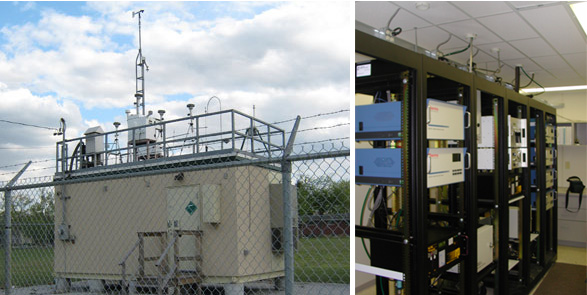Michigan-Ontario Ozone Source Experiment Study
Transboundary influences, from both the U.S. and beyond, account for a significant portion of Ontario’s ozone. In southwestern Ontario, when ozone levels are elevated, over 95% of the ozone is attributable to transboundary sources, with the U.S. contributing to as much as 40% and the remainder attributable to global background.
The Michigan-Ontario Ozone Source Experiment (MOOSE) was a two-year collaborative project designed to improve our understanding of how meteorology and various emission sources of ozone precursors (e.g., NOx from transportation and VOCs from landfills and petroleum refineries) contribute to elevated ozone levels in the southeast Michigan/southwestern Ontario airshed. The Ontario Ministry of the Environment, Conservation and Parks (MECP) participated in the study led by the Michigan Department of Environment, Great Lakes and Energy (EGLE), which also involved the United States Environmental Protection Agency, Environment and Climate Change Canada (ECCC) and the Lake Michigan Air Directors Consortium (LADCO). The National Aeronautics and Space Administration (NASA), National Oceanic and Atmospheric Administration (NOAA), U.S. Forest Service, and several universities also took part.
Fieldwork for the MOOSE study was carried out over the summer periods of 2021 and 2022, and was comprised of three sub-experiments:
- Great Lakes Meteorology and Ozone Recirculation (GLAMOR) designed to:
- better understand and model complex meteorology, lake breezes, urban heat island effects and their impacts on ozone events and transport
- Chemical Source Signatures (CHESS) designed to:
- measure ozone precursors at monitoring stations where ozone values are highest
- characterize ozone precursor emissions in Sarnia and Windsor (e.g., emissions from industrial facilities), and assess their impacts on ozone levels on both sides of the U.S.–Canada Border
- perform air modelling to improve emission inventories of ozone precursors and to inform emission control strategies
- Methane Releases from Landfills and Gas Lines (MERLIN) designed to:
- quantify methane emissions (an ozone precursor) from natural gas pipelines and landfills in southeast Michigan
As part of Ontario’s contributions to the MOOSE study, the ministry enhanced air monitoring activities at its Windsor West AQHI air monitoring station and conducted mobile air monitoring of VOCs (other ozone precursors) upwind and downwind of industrial sources in Sarnia, Windsor, and the U.S./Canada border.

Findings of the MOOSE study include:
- Local ozone production in southeast Michigan is likely most sensitive to VOC emission controls, meaning that reducing VOC emissions has the most impact on ozone mitigation.
- Concentrations of VOCs (including toluene, benzene, methyl ethyl ketone and butene) were generally elevated near industrial facilities.
- Storage of benzene at petrochemical facilities was the main local source contributing to measured ambient benzene levels.
- Toluene and xylenes were mainly linked to petroleum refineries and road vehicles, whereas methyl ethyl ketone was associated with chemical waste handling.
- VOC emissions from solvent use have increased as urban areas expanded, while emissions from transportation sources have declined over the past decades.
- Local traffic and regional/transboundary industrial sources make approximately equal contributions to concentrations of heavy metals (e.g., iron and copper) in Windsor, Ontario.
- VOC emissions from specific facilities are identifiable based on distinct chemical signatures that differentiate emissions from neighboring sources.
- Methane leaks from landfills and natural gas pipelines were observed and could substantially increase ozone formation from VOC and NOx emissions.
The results of the MOOSE study highlighted the need for more improved modeling (e.g., the use of finer-resolution air quality models) to better to assess the effectiveness of emission control strategies in the border region. Based on the findings of this study, a regional-scale reduction in nitrogen dioxide emissions from transportation sources combined with more localized reductions in industrial sources of VOCs is likely the best approach to reducing ozone episodes in southern Ontario. Overall, the MOOSE study provided important insights to help guide emission reduction efforts to improve air quality in the US-Canada border region.
Additional information on the MOOSE study is available in the following publications:
- Healy, R.M.; Sofowote, U.M.; Wang, J.M.; Chen, Q.; Todd, A. Spatially Resolved Source Apportionment of Industrial VOCs Using a Mobile Monitoring Platform. Atmosphere 2022, 13, 1722. .
- Olaguer, E.P.; Su, Y.; Stroud, C.A.; Healy, R.M.; Batterman, S.A.; Yacovitch, T.I.; Chai, J.; Huang, Y.; Parsons, M.T. The Michigan–Ontario Ozone Source Experiment (MOOSE): An Overview. Atmosphere 2023, 14, 1630.
- Yacovitch, T.I.; Lerner, B.M.; Canagaratna, M.R.; Daube, C.; Healy, R.M.; Wang, J.M.; Fortner, E.C.; Majluf, F.; Claflin, M.S.; Roscioli, J.R.; et al. Mobile Laboratory Investigations of Industrial Point Source Emissions during the MOOSE Field Campaign. Atmosphere 2023, 14, 1632.
- Zhang, T.; Su, Y.; Debosz, J.; Noble, M.; Munoz, A.; Xu, X. Continuous Measurements and Source Apportionment of Ambient PM2.5-Bound Elements in Windsor, Canada. Atmosphere 2023, 14, 374.
- Zhang, T.; Su, Y.; Debosz, J.; Noble, M.; Munoz, A.; Xu, X. Sensitivity of Source Apportionment of Ambient PM2.5-Bound Elements to Input Concentration Data. Atmosphere 2023, 14, 1269